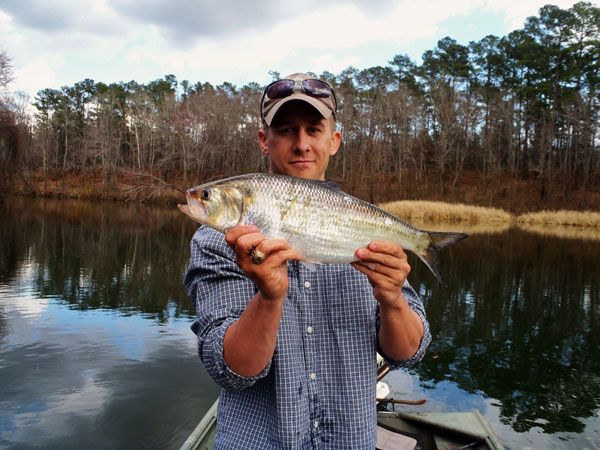By: David Graham – Date Posted: March 22, 2011
In the world of fishing and amongst those who love it, when one considers great migrations the first mental imagery is the seasonal spawn runs of salmon. It is difficult to fathom the incredible gauntlet these fish run as they travel up to two thousand miles from the ocean to the freshwater rivers of their birth. These creatures must swim so far upstream against not only changing currents, but at times hurdle small waterfalls, predators, and of course the ever-present anglers. This, truly, is one of the most remarkable migrations in the animal kingdom. For a southern fisherman like me, this phenomenon is something we may only dream of experiencing.
I have often reflected on the possibility of tangling with a fish so rich in history and folklore. It is sheer joy to pursue a fish which has traveled so far against innumerable odds and unimaginable obstacles to reach its spawning grounds. To be the one element that this fish has, by attrition, naturally proven its self more resilient, cunning, and endearing than thousands of its counterparts which failed to make it to the same point along the way, is the strongest point of pride I could derive from the experience of pulling such an impressive creature from the water.
The salmon run, however, is not the only impressive seasonal spawning migration of the sort. In fact, there is another species of fish which, with equal intensity, makes its way from the oceans to our rivers to complete its natural cycle of life. Right under the nose of most Southeastern anglers is a fish few would consider worthy of consideration as a game species, yet which has all the credentials to be wholly considered a member of that category.

The American Shad is the largest species of herring in North America, growing up to two feet in length and six pounds. They can be found along the entire Atlantic Coast from Florida to Canada. They are an anadromous species, meaning they spend the majority of their life at sea and travel into freshwater through rivers for their annual spawn run.
The spawn run occurs in early spring and can continue for about three months, during which time these fish will be the primary target of an abundance of predatory species from saltwater to fresh as they travel in immense schools. In addition to the element of predation, these fish must often navigate through a myriad of man-made tolls including dams, fish-lifts, and lake systems.
American Shad generally begin to appear around mid-March, when the larger females will be escorted by a number of males.

In South Carolina, shad fishing has become a very popular pastime, specifically along Berkeley County’s Tail Race Canal below the Pinopolis Lock and Dam. Here, vying for the ‘good spot’ is competitive, often motivating anglers to arrive before darkness yields to daylight, simply to line up along the shoreline.
Because these fish spawn during the night, the most active bite comes during the morning. Although the fish will continue to bite all day, there is a slowing down as the sun reaches its highest point. With a primary diet in zooplankton, micro-crustaceans, and small fish, anglers often experience great success using small artificial lures during the spawn.
Among the anglers along the South Carolina Tailrace Canal, the most popular method has been small lead head jigs with curly tail grubs attached. Many anglers will tie several of these grubs onto their lines when the fish are very active; it is not unusual to catch more than one fish at a time.
Like their distant cousin, the Tarpon, American Shad put up an outstanding fight, making a series of acrobatic leaps and full breach areal shows much to the delight of any angler seeking a first-rate battle. These fish travel primarily in the lower part of the water column, so baits and lures should accommodate accordingly, to avoid a top water pattern. Unlike salmon, shad retain the ability to digest and assimilate food during the anadromous migration.
American Shad have a very tender mouth combined with a particularly strong set of shoulders. This presents a unique challenge to the angler who must demonstrate a high degree of finesse if he/she intends to successfully land the fish without having the lure lobbed back into his face. Light tackle is generally sufficient for these fish, although a large female can exceed six pounds and will fight with great vigor and seemingly endless stamina.

Why fish for shad? Aside from the fast action and sheer numbers of fish an angler can enjoy during the spawn run, the roe from a large female is considered a delicacy for many. The double sac which contains millions of tiny eggs can be cooked with a light dusting of flower to create a fine crust. With the additional of bacon, lemon, pepper and parsley, a fine feast ensues.
Shad roe is a low-calorie, high-cholesterol food, and is a highly popular dish in the Southeast; a variety of recipes are available online. Shad ‘meat’ is actually quite bony, but is high in omega 3 fatty acids and low in toxins. Aside from table fare, cut shad is popular bait for catfish anglers, particularly along the Santee Cooper River. Many serious catfish anglers are also serious shad fishermen during this opportune time to stock up on bait.
For an angler seeking simply to gain more knowledge and to become a more complete angler, the American Shad is a very attainable, yet formidable foe. It is a fish with unparalleled character and all the desired qualities to ensure an enjoyable and challenging fishing experience.






